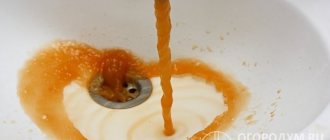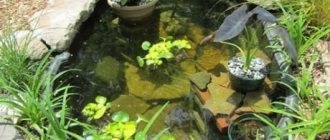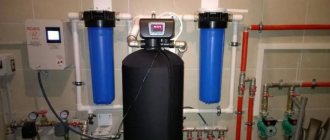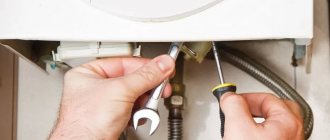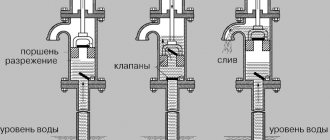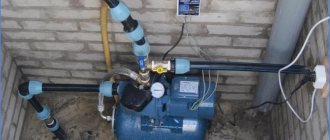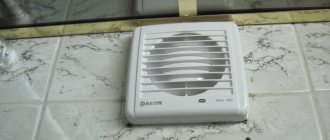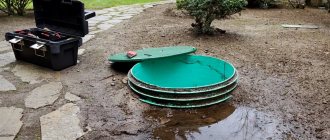A swimming pool at the dacha means water treatments and a pleasant pastime. But the water in this artificial hydraulic structure is not filtered, as is the case in natural reservoirs. Therefore, it gradually stagnates and begins to “bloom”, turning greenish. And an unpleasant smell begins to appear. Therefore, the owners of a reservoir are faced with a problem that creates one question - how to purify the water in the pool, what methods are used for this.
How and with what to clean the water in the pool Source actionquarterly.com
How to clean the water in an inflatable pool
Special products will help clean the walls of the inflatable pool from dirt.
The most common type of pool among summer residents is an inflatable, small one. It is convenient and easy to use, but requires frequent water changes.
If your pool is small, the best way to clean the water is to change it completely. To do this you will need to do the following:
- Drain the contaminated water.
- Thoroughly clean the walls with the chosen product.
- Treat the internal surfaces with protective compounds, which are often sold complete with inflatable pools.
For larger pools, maintenance comes down to disinfection, removing dirt and clearing the walls of mucus. It is necessary to add a disinfectant once a week.
Copper sulfate
Copper sulfate is also used to clean swimming pools, because this product can disinfect water, normalize its acid-base balance, remove turbidity and give the liquid a bluish tint. But you can’t expect much from copper sulfate: it is not able to cope with microorganisms.
Its other drawback is its toxicity, so this product is prohibited for use in children's pools. Copper sulfate is applied only once a season: the optimal, safe amount is 10 g per 1 m3. You can use it in different ways: pour it in parts, or all at once. Ordinary salt can act as an activator: you take three times more of it.
How to clear green water from water in a pool at your dacha
Special agents - aldehydes - will help in the fight against greenery in the pool.
Over time, the water in the pool may turn green, mucus forms around the edges and an unpleasant odor appears - this is where microorganisms begin to multiply.
The chemical method of combating green water is the most effective. In order to disinfect water, they use agents such as aldehydes. They do not contain chlorine and are not hazardous to human health.
Along with aldehydes, chlorine-containing substances also act in the fight against water blooms. It can be liquid, powder or tablets. They should be used strictly according to the instructions; doses are calculated based on the volume of water.
A good way to purify water that has acquired a greenish tint is recirculation (a method of dealing with contaminants using filters and pumps).
Special filters and pumps will help ensure clear water in the pool.
Another method is an ultrasonic water purifying device. It is very effective and is able to clean not only algae, but also slippery deposits. The only negative is that such devices are quite expensive.
When starting cleaning using one or another method, carefully read the instructions and recommended operating procedures.
Chlorine-based chemicals
Such drugs remain popular due to their low cost and effectiveness. Disinfection of water with chlorine-based products (tablets, powders) occurs quickly. However, they are far from the best option. The reasons are a sharp, unpleasant odor of water, a possible allergic reaction. In addition, even a weak solution of chlorine preparations dries the skin, provokes irritation, and can also change the color of swimsuits and swimming trunks.
How to purify water in a swimming pool at the dacha
To purify water, two main methods are used - chemical and mechanical. The chemical method involves adding special substances that purify and disinfect water, and also stop the proliferation of microorganisms.
Ultraviolet light prevents bacteria and phytoplankton from multiplying in water.
The mechanical method is the use of various filters and devices that help not only purify the water, but also remove sediment from the walls of the pool. Filters can be:
- Mechanical. They remove impurities through a filter element. There are models combined with a transfer pump.
- Ultraviolet. The device is a flask containing a UV lamp. Ultraviolet light destroys bacteria and phytoplankton.
Both types of filters can be used simultaneously. In this case, the water is first disinfected with ultraviolet light and then filtered.
A special vacuum cleaner will help to cope with sediment on the bottom and walls. With its help, it will be easy for you to remove flakes that form during chemical treatment of water.
Skimmer for water purification.
Another device that will help the water stay clean is a skimmer. This device cleans the upper aqueous layer, which contains up to 80% of all microorganisms.
Mechanical cleaning
The cleaning option involves the use of hand tools. Suitable for removing debris from surfaces. But this method is not used to remove germs and bacteria. Among the devices that can be used are:
- Brushes to remove leaves, branches and debris;
- Nets that can be used to remove debris and foam formed by flowering;
- Vacuum cleaner for removing dirt from the walls and sand and dirt from the bottom.
This is the most popular method of putting a pond in order. It is carried out at least every other day.
How to clear greens from pool water using folk remedies
You can purify the water in the pool not only with the help of special devices and chemicals, but also with folk remedies.
- The simplest folk method is to add table salt and baking soda to the water. Salt is taken at the rate of 5 kg per 1 ton of water.
- An equally effective remedy is ordinary brilliant green. You won’t need very much of it, only 3 bottles per 10 cubic meters. m of water.
Zelenka and hydrogen peroxide purify and disinfect water.
General care recommendations
Keeping the container clean takes a lot of time. Even when using a special awning, branches still fall into the pond, leaves, debris and dust are blown by the wind. If you do not clean the pool yourself, you will have to change all the water. To avoid this, you should follow these recommendations:
- Filter installation;
- Daily cleaning with a net;
- Treatment of water with chemicals - once every two to three weeks;
- Using an awning at night and in bad weather;
- In winter, the pool must be thoroughly dried and covered.
If a small inflatable “paddling pool” is used, the filling should be changed every 7-8 days and the surfaces located inside should be washed thoroughly.
How to clean a pool with hydrogen peroxide
The most common method of water purification among summer residents is the use of hydrogen peroxide. Due to the fact that this composition has excellent disinfectant properties, it is successfully used both for water purification and for its disinfection.
The advantages of such cleansing include the fact that peroxide helps get rid of foreign odors and decomposition products. Let's look at exactly how you can clean a pool with hydrogen peroxide.
If you want to clean your garden pool with hydrogen peroxide, you need to know exactly its volume. This is necessary in order to correctly calculate the dose of the substance.
If the pool is slightly dirty, after cleaning the pool with hydrogen peroxide, you can swim only after 24 hours.
For effective cleaning per 1 cubic meter. m, 700 ml of hydrogen peroxide is needed, and in case of severe contamination, the dose of this liquid is doubled. With this cleaning method, certain rules must be followed:
- be sure to use gloves;
- After treating the water, you can swim only a day later;
- if the water was heavily polluted and the amount of peroxide exceeded 1 liter per 1 cubic meter. m, then bathing is resumed only after 3 days.
To put your pool in order, you must follow a certain sequence of actions. The cleaning technology is as follows:
- Pour the required amount of hydrogen peroxide into the water.
- If a brown coating has formed on the walls and bottom, use a skimmer.
- After treatment, leave the pool open; there is no need to cover it with an awning.
If you did everything correctly, the water in the pool will be cleared and will not “bloom.”
Cleaning the tank
So, we sorted out water purification. Next up is the second part of the article about cleaning the tank. There are much fewer options here and only mechanical methods are used. Since the walls and bottom of the tank are under water, it is difficult to reach them. Plus, it is necessary to carry out cleaning so as not to raise turbidity into the water. For this you need such devices.
- Here is a pool brush. A telescopic nozzle is put on it, which allows you to reach the walls and bottom of the tank. The disadvantage of this tool is that it picks up dirt from the day. Further water purification is carried out by filters, which indicates an additional and unnecessary load on them - the service life is reduced.
Pool brush
- Water purification using vacuum cleaners is much more effective, but such cleaning uses part of the water from the reservoir. A hose is connected to the outlet pipe on the brush, which is led outside the pool - dirty water will flow through it. Next, the brush is lowered into the water. Now you need to create a pressure difference by sucking water through the return end of the hose. As soon as the water flows, we begin cleaning - the dirt raised by the brush will be partially drawn in by the vacuum cleaner, and the water is drained through the hose.
Mechanical pool vacuum cleaner
- There is no water consumption here, although not all models have it. The device is equipped with an electric motor that draws water inside. It passes through a filter mesh in which debris particles of different sizes settle. The pump must operate under water.
Electric pool vacuum cleaner
- The most technically new method of tank cleaning will be a special robot. This baby has tracks or wheels and a complex sensor system that allows you to scan surfaces in the water. It can move both along the bottom and along the walls of the pool. Systematically and slowly, the robot vacuums the entire tank. A very funny toy that you can enjoy watching for hours.
Robot vacuum cleaner
There are also filters installed inside the robot that require periodic cleaning.
How to clear cloudy water from a pool
If the water in the pool quickly becomes cloudy, then coagulants will help.
Cloudy water may be caused by dust, clay or pollen entering the pool. Such particles may not be captured by filters, and additional means will be required.
In this case, you can treat the water with coagulants. These compounds are capable of transforming microparticles of dust and small debris, first into a jelly-like state, and then into flakes. This mass is subsequently collected with a special vacuum cleaner.
If the water has become cloudy due to contamination with microorganisms, treatment with special disinfectants will help.
Filters
Filters are a mechanical cleaning method. Thanks to them, you can remove small particles and clean all layers of pool water. It should be remembered that the filter must be selected taking into account that it has time to pass water through itself 2-3 times per day.
They need to be washed once every 10 days, and cleaned several times a year. Installation of filters should be carried out by a specialist.
There are many types of filters, each of which has pros and cons.
| Filter | pros | Minuses |
| Sand |
|
|
| Diatomaceous earth |
|
|
| Cartridge |
|
|
More details about filters: Filters
How to remove iron from pool water
If the water in the pool has a brownish tint, this means that metal deposits have appeared in it. The reasons for this phenomenon may be:
- use of reagents containing iron;
- presence of rust in the pipeline system.
Rusty water looks unpresentable, but does not pose any particular danger to human health. But the metal deposits have a negative effect on the pool itself, and rust appears on the parts over time.
Pool filter.
To purify pool water from iron, various filters are used:
- reverse osmosis (with a large amount of iron);
- ion exchange (for a small amount of metal and a water pH of at least 7);
- filter with replaceable cartridges (for water in which the metal content does not exceed 4 mg/l);
- multi-layer iron removal filter that purifies water from metal and organic impurities.
These methods are most effective for purifying water from rust and removing microparticles of metals.
Help of drugs with bromine
This chemical element does not change the pH of the liquid, it is not allergenic, and does not irritate the skin and mucous membranes. However, bromine is effective against microorganisms and algae, and, like chlorine, removes organic contaminants. But it cannot cope with a large volume of work, so it is used together with a chemical “colleague”. The second disadvantage of products containing bromine is their higher price. These products are also produced in the form of powder and tablets.
Other drugs
It must be said that the simplest means do not always cope with their task. Therefore, owners have to consider other options.
If a lot of dirt has accumulated and the liquid is very cloudy, then it makes sense to use other means - coagulants and flocculants. These drugs are able to bind particles, after which they precipitate to the bottom of the pool. Such contaminants are collected with a vacuum cleaner. Examples - AquaDoctor, Aqualeon, Bayrol Quickflook Super, Chemoform Flokfix, Melspring Melpool DualFloc Bio, AquaSTART.
Algaecides are reagents that help cope with mold and algae and prevent their reappearance. Therefore, regular treatment of the pool with these preparations is protection against vegetation and the appearance of silt deposits. Popular algaecide preparations are Aqualand, Algitinn, Chemoform Alba Super K, Maxisan-algaecide, Super-Pul.
Complex preparations can be used for disinfection. Their bases are bromine, chlorine, and organic acids. True, their price is higher than that of simpler analogues: they often cost twice as much.
